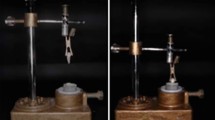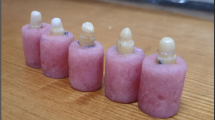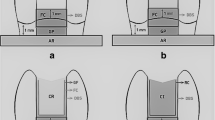Abstract
In order to investigate how to enhance the teeth fracture resistance after the post and core treatment, an in vitro study was conducted to measure the fracture resistance of endodontically treated teeth restored with cast post and core with two kinds of surface treatment technology and acid etching preparation on the dentinal surface. Sixty-four recently extracted human single-rooted first premolars were endodontically treated and sectioned approximately 1.5 mm above the cementoenamel junction to remove the coronal portion. Each specimen received a cast post, core build-up and a metal alloy crown restoration. All teeth were randomly divided into the smooth surface post, core repair group, the sand blasting surface post, and core repair group, each group was divided into 10 s, 30 s, 60 s acid corrosion treatment group and control group. In acid test groups, an acid etching solution was applied for 10, 30 and 60 seconds, respectively, to the root canal wall surface. Each specimen was embedded in acrylic resin block and tested in an electronic universal testing machine. Fracture loads results showed that canal acid etching could increase teeth fracture resistance strength both in smooth groups and sandblasting group, and achieved the best effect when acid etching for 30 s. Sand spray treatment on the surface of the cast metal post can improve the flexural strength of the teeth after postcrown restoration. Acid etching on the root canal wall surfaces and sand spray treatment on the surface of the cast metal post can improve the flexural strength of the root after post-crown restoration. Therefore, these two methods could be used to strengthen the tooth fracture resistance, and maintain the long-term therapeutic effect of cast post and core restoration.
Similar content being viewed by others
References
Temel U B, Van E A, Van M B, et al. Bond Strength and Cement-Tooth Interfacial Characterization of Self-Adhesive Composite Cements [J]. Am. J. Dent., 2017, 30(4): 205–211
Subash D, Shoba K, Aman S, et al. Fracture Resistance of Endodontically Treated Teeth Restored with Biodentine, Resin Modified GIC and Hybrid Composite Resin as a Core Material [J]. J. Clin. Diagn. Res., 2017, 11(9): ZC68–ZC70
Li N, Nikaido T, Alireza S, et al. Phosphoric Acid-Etching Promotes Bond Strength and Formation of Acid-Base Resistant Zone on Enamel [J]. Oper. Dent., 2013, 38(1): 82–90
Pamato S, do Valle A L, de Andrade G H, et al. Does Hybridized Dentin Affect Bond Strength of Self-Adhesive Resin Cement [J]? J. Clin. Exp. Dent., 2016, 8(4): 409–414
Zhang W, Yang W, Wu S, et al. Effects of Acid Etching and Adhesive Treatments on Host-Derived Cysteine Cathepsin Activity in Dentin [J]. J. Adhes. Dent., 2014, 16(5): 415–420
Nakabayashi N. Importance of Mini-Dumbbell Specimen to Access Tensile Strength of Restored Dentine: Historical Background and the Future Perspective in Dentistry [J]. J. Dent., 2004, 32(6): 431–442
Nakabayashi N, K Hiranuma. Effect of Etchant Variation on Wet and Dry Dentin Bonding Primed with 4-META/Acetone [J]. Dent. Mater., 2000, 16(4): 274–279
Nakabayashi N, K Takarada. Effect of HEMA on Bonding to Dentin [J]. Dent. Mater., 1992, 8(2): 125–130
Eliades G, G Palaghias, G Vougiouklakis. Effect of Acidic Conditioners on Dentin Morphology, Molecular Composition and Collagen Conformation in Situ [J]. Dent. Mater., 1997, 13(1): 24–33
Griffiths B M, T F Watson, M Sherriff. The Influence of Dentine Bonding Systems and Their Handling Characteristics on the Morphology and Micropermeability of the Dentine Adhesive Interface [J]. J. Dent., 1999, 27(1): 63–71
Tam L E, R M Pilliar. Effects of Dentin Surface Treatments on the Fracture Toughness and Tensile Bond Strength of a Dentin-Composite Adhesive Interface [J]. J. Dent. Res., 1994, 73(9): 1530–1538
Wang J D, W R Hume. Diffusion of Hydrogen Ion and Hydroxyl Ion From Various Sources Through Dentine [J]. Int. Endod. J., 1988, 21(1): 17–26
Author information
Authors and Affiliations
Corresponding authors
Additional information
Funded by the Construction Engineering Special Fund of Taishan Scholars (No.201511106), the Youth Scientific Research Funds of School of Stomatology, Shandong University (No.2018QNJJ01), Shandong Medical and Health Science and Technology Development Plan (No.2017WS112), National Key Research and Development Program of China (No.2016YFC1102705)
Rights and permissions
About this article
Cite this article
Ma, X., Gao, X., Sun, B. et al. An in Vitro Investigation of Acid Etching Treatment Prior to Post and Core Cementation and Teeth Fracture Resistance. J. Wuhan Univ. Technol.-Mat. Sci. Edit. 34, 1233–1237 (2019). https://doi.org/10.1007/s11595-019-2183-y
Received:
Accepted:
Published:
Issue Date:
DOI: https://doi.org/10.1007/s11595-019-2183-y




